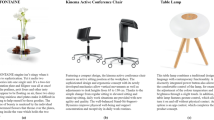Abstract
Although robots are largely designed with industrial, scientific or military aims in mind, many designers seek to endow them with anthropomorphic forms, even at the risk of compromising their functionality. Why do they not content themselves with constructing useful machines, rather than also incorporating human-like features? What drives them to cover their machines with a latex coating to simulate human skin? The utopia of the creation of a double appears also in the world of art, the history of which shows, above all, an outcome that coincides with the abandonment of the naturalistic imperative, and the inauguration of various periods of exploration and innovation. That is why a possible roboaesthetics—i.e. robotics and aesthetics combined could give rise to a new scenario. This view would acknowledges the radical novelty of these ‘species’ and induce the adoption of a new observation level, constructed on the basis of a common project.






Similar content being viewed by others
References
Anzieu D (1989) The skin ego. Yale University Press, New Haven (translated by Segal, N.); L’io-pelle, Rome: Borla, 1994 (translated into Italian by Verdolin A., and Sghirinzetti M.); originally published as Le Moi-peau, Dunod, Paris, 1995)
Apostolos MK (1990) Robot choreography: an artistic–scientific connection. Leonardo 23:1
Duffy BR (2002) Anthropomorphism and robotics. In: The Society for the study of artificial intelligence and the simulation of behaviour—AISB 2002, Imperial College, England, 3–5 April 2002
Fink J (2012) Anthropomorphism and Human Likeness in the Design of Robots and Human-Robot Interaction. In: Ge SS, Khatib O, Cabibihan JJ, Simmons R, Williams MA (eds) Social Robotics, ICSR 2012. Lecture Notes in Computer Science, vol 7621. Springer, Berlin, p 200
Hoffman G, Weinberg G (2010) Synchronization in human–robot musicianship. In: The 19th international symposium on robot and human interactive communication, Viareggio
LaGrandeur K (2011) The persistent peril of the artificial slave. Sci Fict Studies 38(2):232–252
Negrotti M (2012) ‘Music and naturoids: the third reality’. Leonardo 45:3
Penny S (1997) The Virtualization of Art Practice. Art Journal 56(3):30–38
Plessner H (2006) Levels of Organic Life and the Human: An Introduction to Philosophical Anthropology, Fordham University Press, translated into Italian by Fadini U., and Lombardi Vallauri E., I gradi dell’organico e l’uomo. Introduzione all’antropologia filosofica. Bollati Boringhieri, Turin
Reeves N, St-Onge D (2016) Still and useless: the ultimate automaton. In: Herath D, Kroos C, Stelarc (eds) Robots and art. Exploring an unlikely symbiosis, cognitive science and technology. Springer, Singapore, pp 229–254
Schlosser J (1997) Histoire du portrait en cire. Macula, Paris, pp 141–163
Vasari G (1991) Le vite de’ più eccellenti architetti, pittori, et scultori, da Cimabue insino a’ tempi nostri. Einaudi, Torino
Warrick P (1980) The cybernetic imagination in science fiction. MIR Press, Cambridge (Italian translation: Il romanzo del futuro, Bari, Dedalo, 1984, p. 221)
Author information
Authors and Affiliations
Corresponding author
Additional information
Publisher's Note
Springer Nature remains neutral with regard to jurisdictional claims in published maps and institutional affiliations.
Rights and permissions
About this article
Cite this article
Bertasio, D. The old doom of a new technology. AI & Soc 35, 1025–1031 (2020). https://doi.org/10.1007/s00146-020-00986-0
Received:
Accepted:
Published:
Issue Date:
DOI: https://doi.org/10.1007/s00146-020-00986-0




